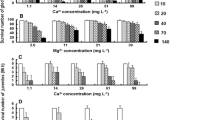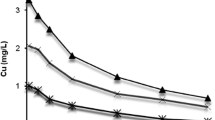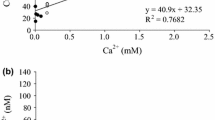Abstract
The aim of this work is to evaluate the toxic effect of water and sediment contaminated with Cu2+ on the survival and growth of juveniles of Hyalella pseudoazteca. The LC50 96 h for Cu2+ in moderately hard water was 0.17 mg/L. The concentration of 100 mg Cu2+/kg in sediment was found to have an inhibitory growth effect. This study provides information on the toxic effects of Cu2+ on a native benthic species occurring in the Pampean region, Argentina and contributes to validate, in this region, the interim use of Cu2+ values recommended by the sediment quality guidelines for the Northern hemisphere.


Similar content being viewed by others
References
APHA (1995) Standard methods for examination of water and wastewater, 19th edn. APHA-AWWA.WPCF, Washington DC
Borgmann U, Norwood W (1997) Toxicity and accumulation of zinc and copper in Hyalella azteca exposed to metal-spiked sediments. Can J Fish Aquat Sci 54:1046–1054. doi:10.1139/cjfas-54-5-1046
Burton GA Jr (2002) Sediment quality criteria in use around the world. Limnology 3:65–75. doi:10.1007/s102010200008
CEQG (2002) Summary of Existing Canadian Environmental Quality Guidelines. www.ccme.ca/assets/pdf/e1_06.pdf
EC (Environment Canada) (1995) Guidence document on measurement of toxicity test precision using control sediments spiked with a reference toxicant. Report EPS 1/RM/30: 1–56 Environment Canada, Ottawa
EC (Environment Canada) (1997) Biological test method: test for survival and growth in sediment using freshwater amphipod Hyalella azteca. Report EPS 1/RM/33: 1–123 Environment Canada, Ottawa
García ME, Rodríguez Capítulo A, Ferrari L (2007) Sensibilidad diferencial al cadmio en Hyalella curvispina. Res. VIII Congreso SETAC LA, p 86
Giusto A, Salibián A, Ferrari L (in press) Biología Acuática Ensayos de toxicidad de sedimentos con Hyalella pseudoazteca con cobre como tóxico de referencia
Kubitz JA, Lewek EC, Besser M, Drake III JB, Gipsy JG (1995) Effects of copper-contaminated sediments on Hyalella azteca, Daphnia magna, and Ceriodaphnia dubia: survival, growth, and enzyme inhibition. Arch Environ Contam Toxicol 29:97–103. doi:10.1007/BF00213093
Lopretto EC, Tell G (1995) Ecosistemas de aguas continentales. Metodologías para su estudio, tomo I. Ediciones Sur
MESL (MacDonald Environmental Sciences Ltd.) (2001) Hyalella azteca sediment toxicity tests, solid-phase Microtox toxicity tests, metals analyses of whole sediment and pore water, and physical characterization of sediments of the Calcasieu estuary, Louisiana. Report for CDM Fed. Prog. Corp., p 73
Milani D, Reynoldson TB, Borgmann U, Kolasa J (2003) The relative sensitivity of four benthic invertebrates to metals in spiked-sediment exposures and application to contaminated field sediment. Environ Toxicol Chem 22:845–854. doi:10.1897/1551-5028(2003)022<0845:TRSOFB>2.0.CO;2
Pasteris A, Vecchi M, Reynolgson TB, Bonomi G (2003) Toxicity of copper-spiked sediments to Tubifex tubifex (Oligochaeta, Tubificidae): a comparison of the 28-day reproductive bioassay a 6-month cohort experiment. Aquat Toxicol 65:253–265. doi:10.1016/S0166-445X(03)00136-X
Shuhaimi-Othman M, Pascoe D (2007) Bioconcentration and depuration of copper, cadmium, and zinc mixtures by the freshwater amphipod Hyalella azteca. Ecotoxicol Environ Saf 66:29–35. doi:10.1016/j.ecoenv.2006.03.003
US EPA (2000) Methods for measuring the toxicity and bioaccumulation of sediment-associated contaminants with freshwater invertebrates, 2nd edn. US-EPA/600/R-99/064, Washington, DC
Weber CI (1993) Methods for measuring the acute toxicity of effluents and receiving waters to freshwater and marine organisms. 4th edn. Environmental Monitoring Systems Laboratory, US-EPA 600/4-90/027
Zar JH (1999) Biostatistical analysis. Prentice-Hall, New Jersey
Acknowledgements
Dr. Adonis Giorgi for his suggestions; Dr. Roberto Servant for Chemical determinations in sediments, CNEA, Argentina. Project granted by ANPCyT (PICT No. 14129/03) and Universidad Nacional de Luján.
Author information
Authors and Affiliations
Corresponding author
Rights and permissions
About this article
Cite this article
Giusto, A., Ferrari, L. Copper Toxicity on Juveniles of Hyalella pseudoazteca González and Watling, 2003. Bull Environ Contam Toxicol 81, 169–173 (2008). https://doi.org/10.1007/s00128-008-9463-0
Received:
Accepted:
Published:
Issue Date:
DOI: https://doi.org/10.1007/s00128-008-9463-0




